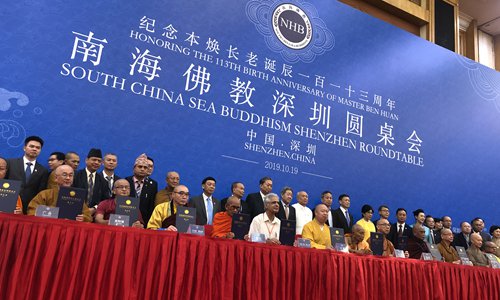HOME >> CHINA
Monks offer peaceful approach to enhance civil communication in South China Sea region
By Leng Shumei in Shenzhen Source:Global Times Published: 2019/10/22 19:48:40

Eminent monks, officials and religious representavies from 18 countries in the South China Sea pose for a photo after signing an agreement at the 2019 South China Sea Buddhism Shenzhen Roundtable on Saturday. Photo: Leng Shumei/GT
Eminent monks from 14 countries around the South China Sea region including China, Nepal and India jointly launched a project on Saturday in Shenzhen, South China's Guangdong Province, to compile the history of Buddhism in the region.
The project is one the six agreements the monks reached during the fourth South China Sea Buddhism Shenzhen Roundtable held by local religious authorities and Shenzen's Hongfa Temple to help deal with regional disputes and promote regional communication.
"We will continue to work together with various countries to translate Buddhist scriptures and send monks to learn from each other in order to enhance mutual understanding in culture and build a platform for communication," Yin Shun, deputy head of China's Buddhist Association and abbot of the Hongfa Temple, addressed the roundtable.
Yin Shun called on attending countries and regions to strengthen cooperation in education, tourism and poverty alleviation and make Buddhism a bond to promote social development and safeguard regional peace.
Cooperation is especially needed given the vital opportunity of constructing the Belt and Road Initiative (BRI), he noted, disclosing that a South China Sea Buddhist tour route connecting various countries is underway.
Booming exchange
Booming Buddhist exchange is an example of enhanced civil communication in the region under the framework of the BRI and demonstration of China's peaceful approach to dealing with regional disputes through communication and cooperation, according to Chinese analysts.
The roundtable mechanism, which uses Buddhism as an entry point to reflect on current situation in the South China Sea and actively promotes healthy religious ties in the region, has contributed to resolving disputes and safeguarding regional peace, Qi Xuchun, vice chairman of the National Committee of the Chinese People's Political Consultative Conference, said at the meeting.
In April, 19 monks from Laos graduated from The Nanhai Buddhist Academy in Sanya, China's southernmost province of Hainan. They are the first batch of foreign students who have graduated from the academy since it was opened by the Hongfa Temple in 2017, according to the academy's website.
Four monks from Mongolia enrolled in the academy in September and will study here for half a year.
The academy provides 40 slots for students from Laos and 60 for students from Cambodia each year, media reported. It is the only Buddhist academy in the world that covers the three major schools of Buddhism listed as Mahayana, Vajrayana and Theravada, said the academy website.
Chinese Buddhist students and believers are also increasingly going to foreign countries to study and make pilgrimage.
Bhikkhu Maitri, president of All Nepal Bhikkhu Association, estimated that about 500,000 Buddhist students and believers will visit Nepal in 2020.
The number was more than 150,000 in 2018, which is reportedly 30 times that of the amount of students in 2000. Chinese visitors have contributed much to the revival of Buddhism in Nepal, the birthplace of the Buddha Sakyamuni, media said.
"As a cultural form of communication, [Buddhism] can help promote civil exchanges and friendship between people from different countries in the region," Chen Xiangmiao, a research fellow at the Hainan-based National Institute for the South China Sea, told the Global Times on Monday.
He quoted a Chinese saying "amity between people holds the key to sound relations between states" and noted that the booming exchanges demonstrate people's mutual pursuit for development and peace in the region, which accords with the purpose of the .
Take the lead
The China-proposed BRI that aims to promote local development and regional ties through the construction of new infrastructure in emerging countries, and the implementation of the BRI under the spirit of fraternity will build a huge community of shared future, including the East Asian community, Former Japanese prime minister Yukio Hatoyama said at the roundtable.
"In order for Asia and the world to help and cooperate with each other and form a giant community, joint efforts should be made by all religions to overcome their differences and achieve world peace. I sincerely hope South China Sea Buddhism can take the lead," he noted.
A youth forum was held for the first time during this year's roundtable with representatives from Chinese Catholic, Christian, Islamic, Taoist and Buddhist communities.
The move is aimed to promote communication among different religions in China and help young people in Chinese religious circles to establish self-confidence in Chinese civilization, according to master Yin Shun.
China has a large population, so the popularity of Buddhism in the country will make great contributions to the religion's global development, Dr. Kumara Bhivamsa, president of Myanmar's State Sangha Maha Nayaka Committee and the Ministry of Culture & Religious Affairs, told the Global Times on Friday.
Dr. Kumara noted that China and Myanmar are countries sharing brotherhood and friendship, and Myanmar absolutely welcomes Chinese monks as well as others to study in Myanmar Buddhist colleges.
Newspaper headline: Buddhist exchanges under BRI
RELATED ARTICLES:
Posted in: IN-DEPTH